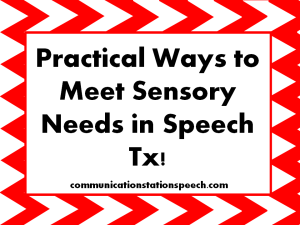Tip Tuesday: Practical Ways to Meet Sensory Needs in Speech Therapy!
Last week we touched base on WHY we should learn about our student’s sensory needs, what sensory processing disorder (SPD) is and how it can affect behavior and learning. Now the question remains, now that we know why types of processing deficits our students have, what do we do about it?
When we talk about meeting the sensory needs of students the first thing that most people say is that they do this by providing “fidgets”. Firstly, I want to say, thank you for acknowledging your student does require some type of sensory input to remain self-regulated so learning can occur. However, a word of caution. Many times I hear fidgets being over used or used as the only sensory accommodation for a student. The truth of the matter is that fidgets can be an appropriate means of addressing our students’ sensory needs, however it is far from the only way to do so. In addition, overuse of fidgets and lack of variety can result in desensitization causing this accommodation to no longer be effective for your student.
There are so many other additional accommodations we can use for our students who are either hypersensitive or hyposensitive to the following:
- Auditory Processing (sound)
- Visual Processing (sight)
- Vestibular Processing (movement)
- Vestibular Processing (muscle tone/coordination)
- Tactile processingOral Processing (taste)
- Olfactory Processing (smell)
- Proprioceptive Processing (sensory seeking behavior)
- Proprioceptive Processing (difficulty with movements and fluidity)
How can we tell if our students are hypersensitive or hyposensitive to any of the above areas? By looking at the behaviors they manifest.
In my product, Practical Ways to Meet Sensory Needs of Students in Speech Therapy Room!, I provide an extensive list of ideas, strategies, accommodations, modifications, and activities any speech-language pathologist can implement within the therapy room, before or after therapy, in the classroom setting, private practice, or home-based therapy in order to meet the sensory needs of their students/clients. This presentation assumes the reader has a basic knowledge and understanding of sensory processing differences and deficits as well as what it means to be hyper- or hyposensitive in each area. If you are new to this information, please refer to Sensory Needs and ASD: What EVERY SLP Should Know!
Practical Ways to Meet Sensory Needs of Students in Speech Therapy Room! 45 page pdf file is immediately downloadable after purchase and addresses the typical behaviors associated with EVERY area of sensory processing difference or deficit including hyper- and hyposensitivities in the areas of: auditory processing, visual processing, vestibular processing (including movement and muscle tone/coordination), tactile processing, oral processing (taste), olfactory processing (smell), and proprioceptive processing (including sensory seeking behavior and difficulty with movements and fluidity). It also addresses the correct use of fidgets in the school/therapy setting. With this product as a guide, any clinician or educator can meet the sensory needs of their students in real time using practical strategies.
You can find more information about this product by clicking on the link above. Be sure to check it out as it can be your go to resource for providing all your students maybe need to provide balance to their sensory systems. Also, look for it this week on sale at my online store!
You can also purchase the sensory bundle pack which includes: Sensory Needs: What EVERY SLP Should Know! and Practical Ways to Meet Sensory Needs of Students in Speech Therapy Room! on sale by clicking here!
Enjoy!


No comments yet.